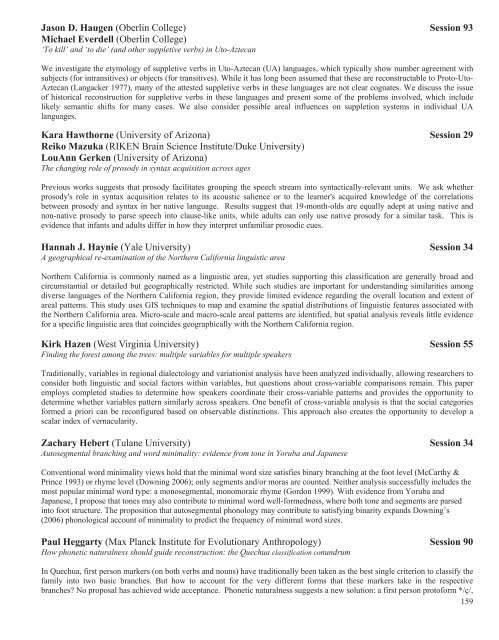here - Linguistic Society of America
here - Linguistic Society of America
here - Linguistic Society of America
You also want an ePaper? Increase the reach of your titles
YUMPU automatically turns print PDFs into web optimized ePapers that Google loves.
Jason D. Haugen (Oberlin College) Session 93Michael Everdell (Oberlin College)‘To kill’ and ‘to die’ (and other suppletive verbs) in Uto-AztecanWe investigate the etymology <strong>of</strong> suppletive verbs in Uto-Aztecan (UA) languages, which typically show number agreement withsubjects (for intransitives) or objects (for transitives). While it has long been assumed that these are reconstructable to Proto-Uto-Aztecan (Langacker 1977), many <strong>of</strong> the attested suppletive verbs in these languages are not clear cognates. We discuss the issue<strong>of</strong> historical reconstruction for suppletive verbs in these languages and present some <strong>of</strong> the problems involved, which includelikely semantic shifts for many cases. We also consider possible areal influences on suppletion systems in individual UAlanguages.Kara Hawthorne (University <strong>of</strong> Arizona) Session 29Reiko Mazuka (RIKEN Brain Science Institute/Duke University)LouAnn Gerken (University <strong>of</strong> Arizona)The changing role <strong>of</strong> prosody in syntax acquisition across agesPrevious works suggests that prosody facilitates grouping the speech stream into syntactically-relevant units. We ask whetherprosody's role in syntax acquisition relates to its acoustic salience or to the learner's acquired knowledge <strong>of</strong> the correlationsbetween prosody and syntax in her native language. Results suggest that 19-month-olds are equally adept at using native andnon-native prosody to parse speech into clause-like units, while adults can only use native prosody for a similar task. This isevidence that infants and adults differ in how they interpret unfamiliar prosodic cues.Hannah J. Haynie (Yale University) Session 34A geographical re-examination <strong>of</strong> the Northern California linguistic areaNorthern California is commonly named as a linguistic area, yet studies supporting this classification are generally broad andcircumstantial or detailed but geographically restricted. While such studies are important for understanding similarities amongdiverse languages <strong>of</strong> the Northern California region, they provide limited evidence regarding the overall location and extent <strong>of</strong>areal patterns. This study uses GIS techniques to map and examine the spatial distributions <strong>of</strong> linguistic features associated withthe Northern California area. Micro-scale and macro-scale areal patterns are identified, but spatial analysis reveals little evidencefor a specific linguistic area that coincides geographically with the Northern California region.Kirk Hazen (West Virginia University) Session 55Finding the forest among the trees: multiple variables for multiple speakersTraditionally, variables in regional dialectology and variationist analysis have been analyzed individually, allowing researchers toconsider both linguistic and social factors within variables, but questions about cross-variable comparisons remain. This paperemploys completed studies to determine how speakers coordinate their cross-variable patterns and provides the opportunity todetermine whether variables pattern similarly across speakers. One benefit <strong>of</strong> cross-variable analysis is that the social categoriesformed a priori can be reconfigured based on observable distinctions. This approach also creates the opportunity to develop ascalar index <strong>of</strong> vernacularity.Zachary Hebert (Tulane University) Session 34Autosegmental branching and word minimality: evidence from tone in Yoruba and JapaneseConventional word minimality views hold that the minimal word size satisfies binary branching at the foot level (McCarthy &Prince 1993) or rhyme level (Downing 2006); only segments and/or moras are counted. Neither analysis successfully includes themost popular minimal word type: a monosegmental, monomoraic rhyme (Gordon 1999). With evidence from Yoruba andJapanese, I propose that tones may also contribute to minimal word well-formedness, w<strong>here</strong> both tone and segments are parsedinto foot structure. The proposition that autosegmental phonology may contribute to satisfying binarity expands Downing’s(2006) phonological account <strong>of</strong> minimality to predict the frequency <strong>of</strong> minimal word sizes.Paul Heggarty (Max Planck Institute for Evolutionary Anthropology) Session 90How phonetic naturalness should guide reconstruction: the Quechua classification conundrumIn Quechua, first person markers (on both verbs and nouns) have traditionally been taken as the best single criterion to classify thefamily into two basic branches. But how to account for the very different forms that these markers take in the respectivebranches? No proposal has achieved wide acceptance. Phonetic naturalness suggests a new solution: a first person prot<strong>of</strong>orm */ç/,159
















